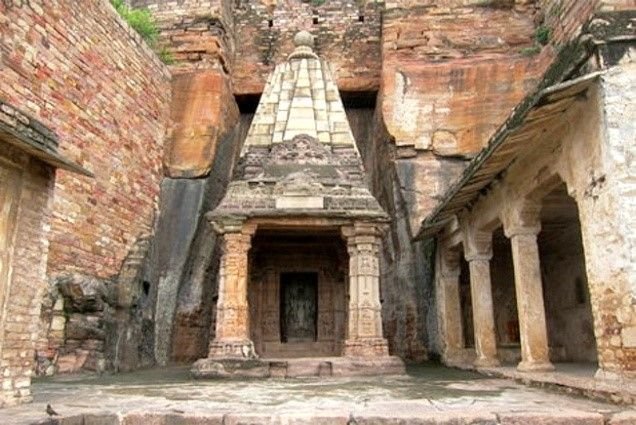Zeroes and Firsts: Where It All Started

– Bhoomee Vats
India has long been credited with the invention of zero. This is further proved when the picture of Gwalior’s Chaturbhuj Temple comes to mind, which is dedicated to Shri Hari Vishnu. The temple, tucked inside the Gwalior Fort, was built under the rule of the sixth Pratihara ruler, King Mihir Bhoj, in 875 AD and is situated on the eastern side of the Gwalior Fort near Hathipaur. This temple holds the oldest inscription of zero that ever existed and is also known as the “Temple of Zero.” Next to the Shwetambar statue of Shri Hari Vishnu is an inscription written in Devnagari script Sanskrit, and it also contains an inscription of zero.
Gwalior was once a princely state governed by the Rajputs and later the Mughals; therefore, it echoes the history of different cultures and heritages. Aside from being culturally rich, the city of Gwalior, through this inscription, holds mathematical history too. The oldest inscription of zero proves that India is not just a hub of different cultures and religions, but it is also significant for the development of mathematics, one of the most important concepts in the world.
Oldest Recorded Symbol
The Chaturbhuj temple of Gwalior is more than just a place of worship; it is a place where everyone can see, through intricate carvings and inscriptions, one of the oldest usages of zero that ever existed. Around the old idol of Shri Hari Vishnu are the inscriptions of different tales and stories, which signify the rich history of India, and it is within these inscriptions that one can find the oldest inscription of zero in the form of the numbers 270 and 50.
Carved into the temple walls, the number 270 holds a large symbolic meaning. It is more than just a number; it stands for the size of the land of the garden, which was donated by the King for the construction and maintenance of the temple. In ancient times, land size was often measured in “hastas,” so the inscriptions point out that the land donated was “270 hastas.” This signifies the abundance of the vastness of zero and how huge it can be while also being equivalent to nothing. Amidst the numerous inscriptions, there can also be found the number 50, which refers to the number of garlands that were supposed to be offered to the deity, Shri Hari Vishnu, daily. These numbers are not just symbols; they represent the understanding and usage of zero in ancient times.
The Significance of Zero in India Historically
Zero, even though being compared to nothing, holds a huge place in the mathematical history of India. The early concept of “emptiness” and “void” was what laid down the foundation for the mathematical adaptation of zero. The concept of “shunya,” which is a Sanskrit word, has deep philosophical roots in India. The great minds of India, such as the Indian mathematicians Aryabhata and Brahmagupta, started working on the calculations regarding zero by the 6th century AD.
According to archaeologists, there have been two different mentions of zero in the history of India that demonstrate its early use. The first one is the stone, K-127, dated back to 683 CE, which was found in the temple complex of Sambor, near the Mekong River. This stone features the number zero depicted as a dot amongst the other numbers, and it is currently preserved in the National Museum in Phnom Penh, Cambodia. On the other hand, the Gwalior inscription of zero in the Chaturbhuj temple uses zero in a way that is closer to the contemporary usage of it. Both these archaeological finds are essential for portraying the history of the number zero in India.
How Zero Became a Superstar
In spreading the concept of hero, a big hand is of an Italian mathematician, Leonardo Bonacci, who is also commonly known as Fibonacci. He learned about the concept of zero and decimal mathematics while he was on a trip to Tunisia with his father, from Arab traders. He immediately realized the importance of the decimal number of series and how they are more convenient to use than the previously used Roman numbers. After learning this new concept, Fibonacci brought it to Europe, where it continued to be flourished and was accepted more and more and hence aiding the spread of zero worldwide.
Fibonacci made this spread possible through the publication of his new book Liber Abaci (Book of Calculation), which was published in 1202. In this book, Fibonacci presented the concept to Europeans, explaining how important it can be in various fields like accounting, commerce, and even currency conversion. The book’s widespread adoption helped in replacing the Roman numbers and the practice of the Abacus with a more efficient and less complicated system, which has the power to prevail longer.
Conclusion
Zero plays an important role in our daily lives without us even realizing it, and is the central concept of today’s modern world, where technology thrives on the binary number system of ones and zeroes. The journey of zero from one continent to another and eventually to the whole world represents the ability of cross-cultural communication that has prevailed throughout the ages. This journey of zero from Indian civilization to the rest of the world is essential for humanity.
Without the discovery of zero, many of the technological advances possible today would never exist. Hence, the inscription of the Chaturbhuja Temple of Gwalior is more than just history; it is a mark of the beginning of science and its roots in a civilization which is considered inferior by the rest of the world. The inscriptions of the Chaturbhuja Temple give us an idea of how our ancestors used the concept of zero and how their usage of it can help us even in modern times. Zero has transformed the world of science as well as humans, and it stands as proof that when science, spirituality, and different cultures combine, something not only complex but also so important for the human race can come out of it.


